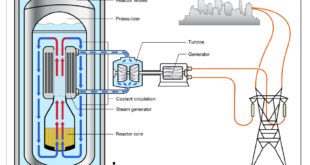NUCLEAR SECRECY WITH $8 BILLION ON THE LINE: SACE CONTINUES FIGHT TO FORCE DISCLOSURE OF U.S. TAXPAYER-BACKED FEDERAL LOAN GUARANTEES TO RISKY VOGTLE REACTOR PROJECT
As Final Arguments Are Filed, Southern Co., Obama Administration Fight FOIA Request to Figure Out Danger to Taxpayers in the Event of Default in Deal More Than 12 Times the Size of Solyndra.
With the Nuclear Regulatory Commission (NRC) believed to be within days of announcing the final federal approval of the controversial Vogtle nuclear project, the Southern Alliance for Clean Energy (SACE) has asked a court to stop more than two years of stonewalling by Southern Co. and the U.S. Department of Energy (DOE), which are resisting any meaningful public disclosure to taxpayers of the risks to which they are exposed in the massive commitment of $8.33 billion in conditional federal loan guarantees to Southern Company and their utility partners for two proposed new nuclear reactors at Plant Vogtle in Georgia.
Of particular concern in the SACE Freedom of Information Act (FOIA) proceeding is the fact that the amount of taxpayer-backed obligations for the proposed Vogtle reactors is more than a dozen times greater than the failed Solyndra loan guarantee.
To date, DOE has produced heavily censored documents that have provided little or no information in an effort to frustrate any analysis that would be useful to taxpayers. Based on the limited information produced to date, it appears that the power companies had to put almost no “skin in the game,” only promising to pay a token credit subsidy fee of what could be as little as 0.5 or 1.5 percent of the total loan principal.
Private lenders have declined to finance new reactors because of the enormously high cost of new nuclear power and the substantial risk that any such investment will fail. In 2003, the Congressional Budget Office (CBO) estimated that the chance of a loan for new nuclear reactor construction resulting in default would be “very high – well over 50 percent.” The Obama administration’s proposed loan guarantee for Vogtle transfers the risk onto American taxpayers, who would pay up to $8.33 billion if Southern Company and its partners run into the same kind of trouble that is routine in the nuclear power industry—cost overruns, delays and project cancellations. And Vogtle does have a history that should trouble taxpayers worried about assuming responsibility for the massive loan guarantee: the original two reactors at the Georgia site took almost 15 years to build, came in 1,200 percent over budget and resulted in the largest rate hike at the time in Georgia.
Stephen A. Smith, executive director, Southern Alliance for Clean Energy, said: “Given some of the lessons learned and political games developing from the Solyndra loan guarantee case, it’s unacceptable and inconsistent that the much larger Vogtle loan isn’t getting more intense scrutiny when the potential risk to taxpayers is much greater. The DOE needs to operate with more transparency now – not less.”
Mindy Goldstein, acting director, Turner Environmental Law Clinic at Emory University School of Law, is representing SACE in its FOIA litigation. She said: “DOE claims that the loan guarantee terms and credit subsidy fee estimates are confidential and may only be viewed by Georgia Power and its utility partners. Let’s hope DOE is wrong. For such information to be withheld as confidential, it must have been obtained from the utilities themselves. If the power companies are literally writing their own guarantees and credit subsidy fee estimates, the Loan Guarantee Program is more flawed than anyone could have imagined.”
SACE filed its FOIA request on March 25, 2010. Under FOIA, DOE was obliged to respond in full to the SACE request by April 22, 2010. On August 10, 2010, when SACE had still not received a complete response, it filed suit in the D.C. District Court. DOE recently made its final document production on December 8, 2011, nearly 20 months after the response deadline. Most of the documents produced by DOE were heavily redacted, and the loan guarantee terms and credit subsidy fee estimates were withheld as confidential information belonging to the power companies.
In October 2011, Taxpayers for Common Sense announced its support for the SACE FOIA request, urging DOE to provide the details of the agreement for the proposed Vogtle reactors—especially because taxpayers are on the hook for such an enormous amount of money. President Ryan Alexander commented, “With more than $8 billion on the line it’s time DOE start shedding some light on this program. Solyndra was the canary in the coal mine for this deeply flawed program, these defaults will continue if things don’t change.”
SACE’s March 2010 FOIA request covered such items as: the Southern Company loan guarantee; related correspondence between DOE and Southern Nuclear Operating Company, Georgia Power Company, Oglethorpe Power Corporation, Municipal Authority of Georgia (MEAG), and the City of Dalton, Georgia; environmental review records related to the loan guarantee request; any credit analysis conducted by DOE in relation to the loan guarantee; all records related to the general terms and conditions of the loan guarantee; and all records related to issuance of the loan guarantee.
SACE has posted the thousands of pages of documents on a website that is open for the concerned public to access. Accompanying the documents are highlighted examples of the egregiously and they believe, illegally, redacted materials. View the Vogtle FOIA documents SACE received, document summaries, a timeline of their FOIA activities, and SACE court filings at http://blog.cleanenergy.org/2012/02/02/vogtle-loan-guarantee-update/.
The continued foot dragging and improper handling by DOE of the SACE FOIA request provide the latest proof of the validity of the criticisms set out in the July 12, 2010 U.S. Government Accountability Office report, “Further Actions Are Needed to Improve DOE’s Ability to Evaluate and Implement the Loan Guarantee Program.” (See http://www.gao.gov/products/GAO-10-627.) The GAO found that the program is inadequately planned and executed, lacks objective performance goals, and provides preferential treatment to nuclear loan guarantee applications over other types of applications.
 Alternative Energy HQ solar power for homes, wind energy, and bio fuel issues
Alternative Energy HQ solar power for homes, wind energy, and bio fuel issues






